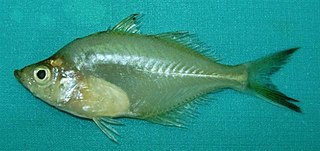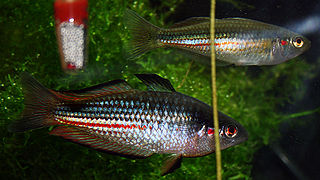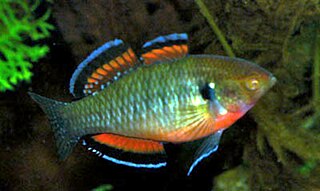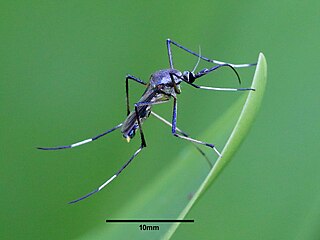
The western Mosquitofish is a species of freshwater fish, also known commonly, if ambiguously, as simply Mosquitofish or by its generic name, Gambusia, or by the common name gambezi. Its sister species, the eastern mosquitofish is also referred to by these names.

Gambusia is a large genus of viviparous fish in the family Poeciliidae. Gambusia contains over 40 species, most of which are principally found in freshwater habitats, though some species may also be found in brackish or saltwater habitats. The type species is the Cuban gambusia, G. punctata. The greatest species richness is in Mexico, Texas, and the Greater Antilles, but species are also found elsewhere in the eastern and southern United States, the Bahamas, Central America, and Colombia. Gambusia species are often called topminnows, or simply gambusias; they are also known as mosquitofish, which, however, refers more specifically to two species, G. affinis and G. holbrooki, which are often introduced into ponds to eat mosquito larvae. As a consequence, they have been introduced widely outside their native range, and frequently become invasive, threatening local species. They are only occasionally kept in aquariums, due to their relative lack of color and the highly aggressive nature of the aforementioned mosquitofish species.

The elongate glassy perchlet is a species of freshwater fish in the Asiatic glassfish family Ambassidae of order Perciformes, the only species in the genus Chanda. It is native to an area of south Asia from Pakistan to Burma, in the Indomalayan realm.

The eastern mosquitofish is a species of freshwater fish, closely related to the western mosquitofish, Gambusia affinis. It is a member of the family Poeciliidae of order Cyprinodontiformes. The eastern mosquitofish is native to the eastern and southern United States from Florida to Pennsylvania and inland to Alabama and Tennessee, while the western mosquitofish has a larger distribution throughout the United States.
Agassiz's perchlet, also known as Agassiz's glass fish and the olive perchlet, is a species of ray-finned fish in the family Ambassidae. It is semi-transparent with dark scale edges forming a pattern over most of the body. It grows to a maximum of 7.5 cm. It is a macrophyte spawner with adhesive eggs. It is endemic to Australia. It was named for the zoologist Louis Agassiz.

Ambassis is a genus of fish in the family Ambassidae, the Asiatic glassfishes. They are found widely in the Indo-Pacific region, with species in fresh, brackish and coastal marine waters.

Acanthopagrus australis, the yellowfin bream, also known as sea bream, surf bream, silver bream or eastern black bream, is a species of marine and freshwater fish of the porgy family, Sparidae. It is a deep-bodied fish, occasionally confused with Acanthopagrus butcheri, but is generally distinguished by its yellowish ventral and anal fins. It is a popular target for recreational fisherman due to its capacity to fight well above its weight coupled with its table quality.

Culex annulirostris, commonly known as the common banded mosquito, is an insect native to Australia, Fiji, Micronesia, the Philippines and Indonesia. It is regarded as a serious pest species throughout its range.

Kunjin virus (KUNV) is a zoonotic virus of the family Flaviviridae and the genus Flavivirus. It is a subtype of West Nile virus endemic to Oceania.

The eastern mosquitofish was introduced to Australia in 1925, and has since spread from the northeast coasts to New South Wales, southern Australia, and parts of Western Australia by 1934. Currently, known populations of wild mosquitofish occur in every state and territory except the Northern Territory, and are found in swamps, lakes, billabongs, thermal springs, salt lakes, and ornamental ponds. Mosquitofish are considered a noxious pest, especially in New South Wales and Queensland, and it is illegal to release them into the wild or transport them live into any of the states or territories. Mosquitofish were introduced by military and local councils to control mosquito populations, however there has been no evidence that Gambusia has had any effect in controlling mosquito populations or mosquito-borne diseases. In fact, studies have shown that Gambusia can suffer mortalities if fed only on mosquito larvae, and survivors show poor growth and maturation. Gambusia typically eat zooplankton, beetles, mayflies, caddis flies, mites and other invertebrates; mosquito larvae make up only a small portion of their diet. Gambusia are eaten by juvenile cod.

Melanotaenia duboulayi, the crimson-spotted rainbowfish, less commonly known as the Duboulay's rainbowfish, is a species of freshwater rainbowfish endemic to eastern Australia. M. duboulayi has also been kept in aquariums since the early 20th century, and is the original Australian rainbowfish.

Hypseleotris compressa, the empire gudgeon, is a species of Gobiiform fish in the family Eleotridae endemic to Australia and south-central New Guinea.

The Pacific blue-eye is a species of fish in the subfamily Pseudomugilinae native to eastern Australia. Described by Austrian naturalist Rudolf Kner in 1866, it comprises two subspecies that have been regarded as separate species in the past and may be once again with further study. It is a common fish of rivers and estuaries along the eastern seaboard from Cape York in North Queensland to southern New South Wales, the Burdekin Gap in central-north Queensland dividing the ranges of the two subspecies.

Ambassis macleayi, commonly known as Macleay's glassfish, Macleay's glass perchlet, Macleay's perchlet, reticulated glassfish, reticulated perchlet, or network perchlet, is a species of freshwater fish in the family Ambassidae. It is native to northern Australia and the trans-Fly River region of New Guinea. It is a fish with a vertically flat, narrow body and a standard length generally between 35 and 45 mm, with large specimens reaching 77 mm (3.0 in) long. It generally eats water fleas and other small invertebrates. This fish is considered to be a least-concern species according to the International Union for Conservation of Nature (IUCN), although it could suffer from habitat degradation due to feral pigs and invasive water plants such as the water hyacinth. The fish is suitable for aquarium use in tanks containing other non-aggressive species.

Ambassis miops, commonly known as the flag-tailed glassfish, is a species of fish in the family Ambassidae. It is native to eastern Australia. It is found only in a few coastal sites along the North Queensland coast. A distinguishing feature of this species is a tiny spine is situated above the rear corner of the eye.

Ambassis nalua, the scalloped glassfish or scalloped perchlet, is a species of fish in the genus Ambassis. It is native to the Indo-Pacific region, form India to Australia and New Guinea, where it occurs in bays, estuaries and mangrove-lined creeks.

Ambassis jacksoniensis, commonly known as the Port Jackson glassfish or Port Jackson perchlet, is a species of fish in the family Ambassidae native to eastern Australia. It gains its common name from its transparent appearance.

Toxorhynchites speciosus is a mosquito species in the genus Toxorhynchites found in Australia.

The ringed brown snake is a species of venomous elapid snake native to a broad swathe of inland Australia, from western New South Wales and Queensland to Western Australia.

The Sydney skate is a species of skate of the family Rajidae native to waters off the east coast of Australia.


















